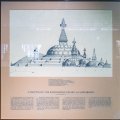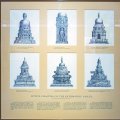Patan Museum (Nepal): photo 121
Photo 121 of 212 in Gallery: Patan Museum (Nepal)

Image title: Terra-cotta Chaitya
Description of the photo
Terra-cotta Chaitya [Chaitya with unique Patan motifs, Nyauta, Patan, 17th century, height 263cm; Drawing by Ian Goodfellow, May 1988]—
This elaborate Terra-cotta chaitya is believed to be the reliquary for the molds used to imprint Buddha images onto bricks. The Mahabauddha temple in Patan’s southern quarter, designed after a prototype in Bodhgaya, India, was constructed with these bricks and consecrated in A.D. 1610. The sacred chaitya which stores the molds is dedicated to the tools of craftsmen such as the potters' caste who traditionally live in the surrounding area, the eastern quarter of Patan.
The base story, drum, dome, and finial with thirteen tiers (of which five are lost) are shaped like a small temple, following the same formula as the Shikharakuta chaitya. A platform with eleven tiny niches on each side mediates between the chaitya proper (above) and the recently cemented plinth (below). Each niche holds an image of Buddha Shakyamuni. The niche with its elaborate tympanum repeats the motifs of the Mahabauddha temple, reduced to a quarter of the original size.
Another set of motifs reflects the first discourse the Buddha delivered in the Deer Park of Sarnath near Benares. Both the trilobed arch and the triangle above the niche recall the Three Jewels: the Buddha, his teachings (dharma), and the community of monks (samgha). The flaming steps of the tympanum support a lotus from which a vajra scepter emerges. These motifs of Buddha’s discourse were never duplicated outside of Patan in the many centuries that followed.
The motifs of the tympanum are repeated as a crowning element. A pair of deer worship the triangle that incorporates the Wheel of the Law the Buddha set in motion in the Deer Park. These details visualize one of the eight most important and constantly depicted events in the life of the Awakened One. (Unfortunately, after this drawing was made the dome was disastrously cemented).
Gallery information:
The Patan Museum is located on the Durbar square of Patan (Lalitpur/Lalitapura, Kathmandu, Nepal) which is associated Keshav Narayan Chowk (Keshavnarayan)—a form of Lord Vishnu. Being listed as a World Heritage Site, the whole of Durbar square is filled with exquisite temples, sculptures and other ancient structures, of which the ancient history history can be traced to the Malla Kings of Lalitpur. It is an important site for both Buddhism and Hinduism.
Photo details:
Date: 2019-12-02
Camera: SONY ILCE-6400
Exposure: 1/160
Aperture: f/3.5
ISO: 2500
Focal length: 18mm
High resolution:
Download file
Size: 3.28 MB
Resolution: 2154 x 2000
© Photograph by Gabe Hiemstra.
License: CC BY-NC-ND 4.0

